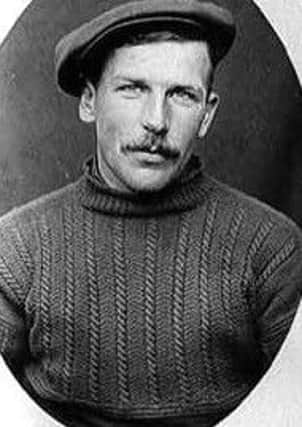The ‘tartan of the sea’ enjoys a huge swell of interest


It could me a myth cooked up on the quayside by the herring girls but it is said that you could tell where a fisherman was from the knit of his gansey.
The truth is maybe more complex than that given that fishermen and the gutters who travelled the coast with them were forever on the move.
Advertisement
Hide AdAdvertisement
Hide AdBut it is clear that the gansey is enjoying a new wave of popularity as both a social document and historical pointer amongst those interested in the past of the fishing industry and the traditional crafts promoted by the communities which served it.


The Moray Firth Partnership recently mounted an exhibition of around 50 ganseys, mainly collected from homes around the north and north east of Scotland.
While original gansey knitters may be a scarce breed today those behind the collection witnessed a great bond forming with the garments and their place in their communities.
The collection gathered by the MFP is now being sent to Alaska to go on show, such is the interest in the seamless, tightly knit jumpers, that were usually water resistant and comfortable to wear during the harsh physical work demanded of the job.
Fishermen often had a ‘best gansey’ and a look through old photographs of north east couples often show women in their elaborate finery - while their partner sits proudly in his best woollen.
Gordon Reid, an archivist from Wick in Caithness, has spent the last 20 years knitting the jumpers after being shown the skill by his wife on their honeymoon.
Mr Reid said: “They really are beautiful garments. They are so fine, detailed and intricate, I think of them as a monochrome Persian carpet.
“They are also unique. You can’t go into a shop and buy one so when someone makes it for you, its all for you.
“They really are a labour of love.”
Advertisement
Hide AdAdvertisement
Hide AdMr Reid, 55, said the main feature of the gansey was the ‘underarm gussett’.
He said: “It is possibly the least romantic name possible but it means you could lift the garment over your head and it doesn’t ride up your waist.
“And part of the reasons they are so heavily patterned is that the little indentations trap air and help to keep you warm.”
Mr Reid said that collectors had had difficulty in drawing together historic ganseys as “wool never survives”.
He added: “Wool is one of the first things to go, people don’t think of wool as valuable.”
Mr Reid likened the search for the jumpers like detective work but said the garments being made today - usually knitted on a single round needle -were highly evolved versions of the original patterns that had been shared and traded around the coastline.
On the potent theory that a dead fishermen could be identified due to his gansey, Mr Reid remains open minded.
He said: “I have met and spoken to people in Scotland adamant that their families told them this was the case.
Advertisement
Hide AdAdvertisement
Hide Ad“What I would say is there is no evidence for it although I am wise enough to say that no evidence doesn’t necessarily mean its not true.”
Deb Gillanders, a textiles expert who has researched ganseys across the country, is less convinced.
“To say they were the fisherman’s tartan was not that inaccurate. A lass would learn to knit with her family and then at 15 go travelling with the herring lassies. They would go with their own patterns but they would also come back with others.”
She said if men were lost at sea, they would rarely be brought back to shore.
Ms Gillanders said: “I think what you could say is that you could recognise the region where the knitter learned their craft.”
“But the idea would can identify a sailor from his gansey doesn’t really wash.”
Work carried out by the Moray Firth Partnership has established various knitting styles adopted in the north and north east, from the anchors and cables of Lossiemouth and Hopeman, to the hoof prints of Avoch and the low heapies of Fraserburgh.
Mr Reid said the information exchange about patterns had become immense, partly due to the internet.
Advertisement
Hide AdAdvertisement
Hide AdHe added: “When we started out looking at ganseys, there was very little out there, just a couple of books.
“Now so many people are piecing together the life of ganseys.
“It is not a living tradition - but it is a tradition being honoured, respected and revived.”